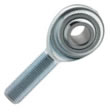
Are you familiar with rod ends? They are commonly used on automotive steering links, tie rods and control rods. Rod ends feature a shank and an integrated head, the latter of which contains a bearing. You can connect them to parts that require an articulating joint. Below are six facts about rod ends and how they work.
#1) Male and Female Styles
Not all rod ends are the same. You can find them in male and female styles. Both male and female rod ends feature a shank with an integrated head. Male rod ends simply have a solid shank with external threading. Female rod ends, on the other hand, have a hollow shank
#2) Also Known as Heim Joints
Rod ends are also known as heim joints. This is a reference to their origins. The origins of the modern-day rod end can be traced back to the mid-20th century. During World War II, the governments of the Allied forces awarded H.G. Heim Company a patent to manufacture rod ends. Rod ends are now manufactured by other companies, but many people still refer to them as “heim joints.”
#3) Available in Different Sizes the
You can find rod ends in different sizes. And you’ll need to choose a rod end in the right size for your intended application. Some rod ends are wider or longer than others. The ball size of a rod end may also vary. Regardless, if you’re looking to buy a rod end, you should choose the right size. for your intended application.
#4) Allows for a Limited Degree of Misalignment
One of the unique characteristics of rod ends that distinguishes them from other types of mechanical joints is that they allow for a limited degree of misalignment. Other types of mechanical joints typically require proper alignment with the part. Rod ends are unique in the sense that they allow for a limited degree of misalignment. The part to which a rod end is connected can move slightly.
#5) Versatile Alternative to Clevis Ends
Rod ends offer a versatile alternative to clevis ends. Clevis ends are mechanical joints as well. The problem with clevis ends, though, is that they require a perfect 90-degree angle alignment. Rod ends don’t require this same perfect alignment. Therefore, you can use a rod end in applications where clevis ends won’t work.
#6) Available in Right-Hand and Left-Hand Thread Types
Rod ends are also available in right-hand and left-hand thread types. The thread type of a rod end is determined by its style. Male-style rod ends have external, left-hand threads. Female-style rod ends have internal, right-hand threads.
